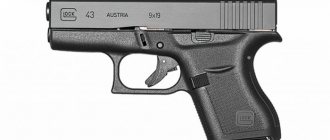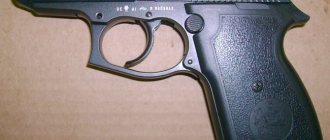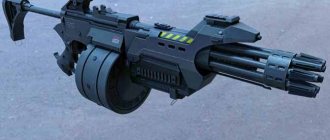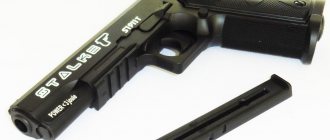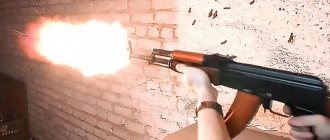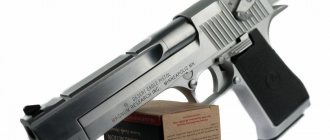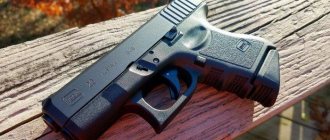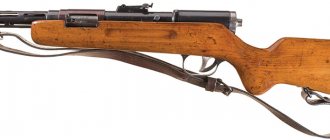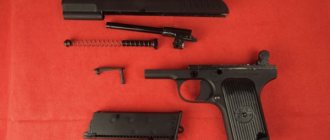| Kalashnikov submachine gun 1942 | |
| Type | submachine gun |
| A country | USSR |
| Service history | |
| Years of use | not accepted for service |
| Production history | |
| Constructor | Kalashnikov, Mikhail Timofeevich |
| Designed by | 1942 |
| Manufacturer | not mass produced |
| Characteristics | |
| Weight, kg | 2,9 / 3,233 |
| Length, mm | 750 / 535 |
| Barrel length, mm | 250 |
| Cartridge | 7.62×25 mm TT |
| Caliber, mm | 7,62 |
| Work principles | semi-free shutter based on the interaction of two screw pairs |
| Rate of fire, rounds/min | 824 |
| Sighting range, m | 500 |
| Type of ammunition | sector magazine for 30 rounds |
| Aim | sector |
The Kalashnikov submachine gun
is a semi-blowback submachine gun created by M. T. Kalashnikov in 1942. The second of the weapons he developed (the first submachine gun that used the removal of powder gases has not survived)[1].
History of creation
While in the hospital after being wounded, Senior Sergeant Kalashnikov became obsessed with the idea of creating his own model of automatic weapons. He began to make sketches and drawings, comparing and analyzing his own impressions of the battles, the opinions of his comrades in arms, and the contents of the books in the hospital library[2]. The advice of one paratrooper lieutenant, who had worked at some research institute before the war and had a good knowledge of small arms systems and the history of their creation, was also useful [3].
At the direction of the doctors, he was sent for further treatment on a six-month leave. Returning to Matai, with the help of depot specialists, three months later he created a prototype of his first model of a submachine gun (which has not survived to this day).
From Matai he was sent to Alma-Ata, where he produced a more advanced model in the training workshops of the Moscow Aviation Institute, which was evacuated to the capital of Kazakhstan. Later, the sample was presented to the head of the Military Engineering Academy named after. F. E. Dzerzhinsky to A. A. Blagonravov, an outstanding scientist in the field of small arms.
Although Blagonravov's review was generally negative, he noted the originality and interestingness of the development and recommended that Senior Sergeant Kalashnikov be sent for further training. Later, the Kalashnikov submachine gun[4] was presented to the Main Artillery Directorate of the Red Army. Noting some shortcomings and a generally successful design, GAU specialists did not recommend adopting the Kalashnikov SMG for service for technological reasons. The conclusion read:
The Kalashnikov submachine gun is more difficult and expensive to manufacture than the PPSh-41 and PPS, and requires the use of scarce and slow milling work. Therefore, despite many attractive aspects (light weight, short length, the presence of a single fire, successful combination of translator and fuse, compact cleaning rod, etc.), in its present form it is not of industrial interest.
The Makarov pistol is like a Kalashnikov among machine guns
Top ten
The Makarov pistol is one of the best pistols of the 20th century in its class: in 1994, it was included in the list of the ten best pocket pistols of the last century, compiled by the American Guns Magazine.
The technology for creating PM was at one time transferred to China, the GDR, and Bulgaria. “I think there were also Pam clones. Basically, there were countries that were within our orbit of influence. Who would offer our opponents anything?” - Dragunov joked.
"Kalashnikov" among pistols
The PM has a fairly wide range of applications, its main advantage is ease of assembly and operation, and, according to the expert, it has successfully filled the niche of a concealed carry pistol.
“In its class, the Makarov pistol can be compared to the Kalashnikov assault rifle among assault rifles. But, nevertheless, to say that its creation was a breakthrough in the field of pistol manufacturing would probably be wrong, since many of the technologies used in the PM already existed before its creation,” the agency’s interlocutor explained.
In his opinion, the PM is still one of the best pistols in its class. “If we take the class of compact pistols, then I think that the PM is still one of the best. Well, of course, they appeared better, but not so much that you could throw away the PM and take some other one,” Dragunov concluded.
Prestige Weapon
The President of the International Association of Veterans of the Alpha anti-terrorism unit, Sergei Goncharov, called the Makarov pistol a weapon that special forces trust.
“Our special forces and the Armed Forces have been using these weapons for a very, very long time. In terms of all types of weapons that we use, the PM pistol is the most combat-ready weapon, which almost never misfires or fails. This is a weapon that we trust,” Goncharov told RIA Novosti.
The officer stated that he would never exchange the PM for foreign analogues. “If we talk about the developments that our scientists create, or those that we buy abroad, Glock or something else, then, for example, for me the PM is the most reliable weapon, the weapon of my youth, the weapon of prestige . And today, no matter what happens, I would not change the PM pistol,” he said.
Last chance pistol
The special forces veteran said that for him the PM is a holy weapon, which sometimes becomes the last hope in battle.
“All the military know that there are eight cartridges in the magazine, but we always had a ninth, spare cartridge, so some say that the Makarov pistol is the last hope. Makarov for me is a holy weapon,” Goncharov concluded.
Design
The submachine gun had a semi-free bolt, the retreat of which was slowed down due to the interaction of two screw pairs in the bolt group: the bolt - rotary coupling and the rotary coupling - screw shank. During the rollback of the moving parts, the bolt moves longitudinally along the guides of the receiver, the clutch rotates, and the shank remains stationary - it is secured from rotation by a protrusion that fits into a groove at the end of the receiver. In this case, the coupling, screwing onto the shank, is turned out of the bolt. Thus, the clutch and the shutter, moving backward, seem to “scatter” relative to each other, the recoil speed of the shutter decreases and the time for complete opening of the shutter increases. This automatic operation scheme is unique for this type of weapon[1].
The general external design of the weapon, with a front vertical fire control handle, was somewhat reminiscent of the American M1928 Thompson submachine gun, which was available in small quantities in the Red Army (it is unknown, however, whether Kalashnikov was familiar with it).
The USM is a striker type, allowing both single and continuous fire. The fire selector is a flag type, located on the left side of the trigger frame, and at the same time serves as a fuse, locking the trigger (somewhat similar to the AK safety selector). The front end of the barrel casing serves as a compensator brake[1].
The prototype is kept in the collection of the Military Historical Museum of Artillery, Engineering Troops and Signal Corps[1].
Subsequently, in 1947, Kalashnikov also created another small-sized submachine gun, already partially based on the design of his own machine gun. It was also not accepted into service.
Automatic Kalashnikov pistol
In 2020, the great Russian weapons designer Mikhail Timofeevich Kalashnikov turns 100 years old. This designer has gone down in history forever thanks to his machine gun, which is known today throughout the world and is one of the symbols of modern automatic weapons.
At the same time, it would be naive to believe that the famous designer worked on only one machine gun and its derivatives. At different times, the designer created both submachine guns and sniper rifles. One of his little-known developments to the general public was an automatic pistol, which participated in the competition simultaneously with the Stechkin pistol, which was eventually adopted by the Soviet Army.
Today, the very idea of adopting an automatic pistol that could fire in bursts into service with the army is perceived by many experts as erroneous. However, in the middle of the 20th century, before and after the Second World War, quite a lot of attention was paid to such developments, especially abroad. Mainly, foreign designers worked on automatic pistols and submachine guns chambered for the common 9x19 mm Parabellum cartridge. At the same time, in the Soviet Union this topic was ignored for quite a long time, although the issue of arming tank crews, various armored fighting vehicles and self-propelled artillery units with small arms could not be resolved by using an assault rifle, which was created for a more powerful intermediate cartridge, as it could not be it was also resolved due to the Makarov pistol. The machine guns did not suit the military due to their dimensions, and the PM in most cases was recognized as an insufficiently effective weapon on the battlefield.
Already at the end of 1945, the Main Artillery Directorate of the Red Army prepared tactical and technical requirements for new pistols and cartridges for them. The preparation of performance characteristics for new products was carried out with a synthesis of the extensive experience that was accumulated during the Second World War. Thus, a new pistol cartridge of 9 mm caliber with a sleeve length of 18 mm was created by B.V. Semin at OKB-44 (today the famous TsNIITOCHMASH) precisely in accordance with the instructions of the GAU. The first batch of cartridges was transferred for testing already in 1947. If we talk about pistols, the army expected to receive two models of short-barreled weapons that were fundamentally different from each other. The first pistol was supposed to be light in weight (no more than 700 grams) and small in size; it was supposed to become a personal self-defense weapon for officers of the Soviet Army. The second pistol was planned to be a “personal self-defense weapon” for officers who were supposed to be in the zone of direct contact with the enemy and could come into fire contact with enemy infantry.
Today we know that the compact pistol, which was adopted by the Soviet Army in 1951, turned out to be the today famous Makarov pistol (PM), but the role of the “large automatic pistol”, which entered service not only with Soviet officers, but also with crews military equipment and artillery crews - the Stechkin automatic pistol, no less famous today, became the APS. At the same time, the fact remains in the shadows that the competitors of the Stechkin pistol, at the time it was put into service, were other models of automatic pistols chambered for the same 9x18 mm cartridge, among which were models proposed by Kalashnikov and Voevodin.
The Kalashnikov automatic pistol of the 1950 model used a blowback-breech automatic system. The return spring was located around the stationary barrel of the pistol, the trigger mechanism of the model was non-self-cocking, and the fire mode switch located on the left side allowed the pistol to be fired in both single shots and bursts. A standard magazine was supposed to hold 18 rounds of 9x18 mm caliber. There was a special groove on the back of the handle, which was intended for attaching a wooden butt holster. The weight of the pistol without cartridges was 1.25 kg, with a holster the weapon already weighed 1.7 kg.
Based on test results, the model was modernized several times. By 1951, the Kalashnikov automatic pistol received a new magazine designed to hold 20 rounds, as well as a new sight and a changed location of the safety switch. Despite these changes in the competition, the model was inferior to the pistol proposed for the competition by Stechkin. For this reason, the Kalashnikov automatic pistol of the 1950 model remained forever in history only in the form of a few manufactured prototypes.
9x18 PM cartridges
It was really difficult for the Kalashnikov pistol to compete with the APS; perhaps this model did not even reach the stage of field testing. The reason was that during the period of creating the pistol, testing and adopting the Stechkin automatic pistol, Mikhail Timofeevich was busy working on his main topic - the assault rifle and machine gun, concentrating primarily on the development of long-barreled models of firearms. In this area, Kalashnikov managed to achieve well-known achievements and significant successes. At the same time, the Kalashnikov automatic pistol, being presented in several versions, has forever remained history. One of these pistols is today in St. Petersburg in the collections of the Military Historical Museum of Artillery and Engineering Troops and Signal Corps.
Tankers, artillerymen, and pilots received a Stechkin pistol. The APS, which was also equipped with a wooden holster-butt, could fire single shots and bursts. At the same time, the military use of the pistol revealed a number of shortcomings, which included the large dimensions of the weapon, the inconvenience of wearing a massive holster-butt, and the impracticality of automatic fire. The handle of the Stechkin automatic pistol with a small angle of inclination required soldiers and officers some time to get used to and was not very suitable for “instinctive” shooting offhand. The military considered this weapon to be excessively large and inconvenient for everyday carry, especially in peacetime. The icing on the cake was that along with the APS it was necessary to carry 4 fully loaded spare magazines (20 rounds each) in pouches, which further burdened the military personnel.
Already in 1958, the APS was discontinued, and in the early 60s of the last century, most of these pistols were moved to storage, although they are in service with some categories of military personnel, in particular machine gunners (Kalashnikov machine gun) and grenade launchers (RPG-7) , this pistol remained in service until the early 1980s. At the same time, regardless of whose pistol: Kalashnikov or Stechkin would be adopted, they also had other common shortcomings, for example, the chosen cartridge. The ballistic characteristics of the 9x18 mm cartridge could not provide a high initial velocity of the bullet, and therefore a good flat trajectory. In addition, the 9-mm bullet had insufficient penetration, and against targets using personal protective equipment, for example, body armor, such a cartridge was ineffective in principle. Among other things, there was a great danger of ricochets indoors.
It is no coincidence that in the mid-1970s, the “Modern” competition was launched in the Soviet Union, the main task of which was to create and adopt not new automatic pistols, but small-sized assault rifles chambered for the standard 5.45x39 mm cartridge. The weapon that replaced the APS pistol in the Soviet Army was called AKS-74U and was developed by Mikhail Timofeevich Kalashnikov. This model was a shortened version of the AKS-74 assault rifle. So the spiral of history made another circle.
Source
Notes
- ↑ 1234
Article in the magazine "Gun". - Fedorov V. G.
Evolution of small arms. - M.: State Military Publishing House of the Narkozhat of Defense of the USSR, 1938. - 317 p. Archived copy from June 30, 2009 on the Wayback Machine - A. A. Buldakova.
Life and work of the designer (Russian) (html).
almanac “Business Glory of Russia”
. Publishing house "Slavitsa". Retrieved December 1, 2009. Archived July 6, 2012. - Kalashnikov submachine gun 1942
AKSU-74 (“Ksyukha”), caliber 5.45
(Photo source)
Received the unappetizing nickname "Spitter" due to the fact that it quickly overheats. On the other hand, it is not designed for long-term shooting. According to experienced people, “Ksyukha” is indispensable for those for whom a regular AK-74 is too big - for tankers, artillerymen, signalmen and others who do not have enough space.
RPK, caliber 7.62
(Photo source)
The downside is the limited magazine capacity compared to a conventional machine gun belt. The drum partially solves the problem, but not completely. Plus - an elongated barrel and the ability to use it as a sniper rifle if you attach an optic. When the author of these lines took him into her tender feminine hands, the word “intelligence” flashed in her mind. Yes, this word is more than applicable to a machine gun if it is a RPK!
"Episode 100"
“Kalashnikov in a tailcoat” (photo source)
There are both 5.45 and 7.62 - whatever the customer wishes. There is also an option for NATO 5.56x45. Folding polyamide stock (inheritance of the AK-74M), handguard made of the same material. On a number of modifications there is an “intermediate” firing mode with a cut-off of three shots, Picatinny rails installed at the customer’s request for attaching equipment. A good foundation for entering the 21st century, and the accuracy, as it turned out, was good - if only there was a suitable cartridge.
RPK-74, caliber 5.45
“Good in exercises, but not in battle!”
(photo source) What’s good about a machine gun is that your ammunition is carried by other soldiers. That is, you, happy RPK user, like it. This is the same Kalash, only elongated. Minus: there was a drum magazine for 7.62, but why isn’t there one for 5.45? A regular domestic one, in any case?
PL-15K, aka Lebedev compact pistol, caliber 9 mm
(Photo: Kalashnikov Media)
I ended up in last place, but I can still make it. This is the “dark horse” of the Kalashnikov concern, presented at the Army-2017 forum. It has been stated that the PL-15K can replace the legendary Makarov in the army, but without practical experience this is still nothing more than loud PR. We included the baby in the rating in advance. Whether he will have a career as a successor to Makarov is one of the most intriguing weapons mysteries.
AKMS, caliber 7.62
“Indispensable in urban combat!”
(photo source) The folding stock, on the one hand, reduces the dimensions, on the other hand, the design is such that it is impossible to firmly fix the weapon, vibration reduces the already not record accuracy. However, the weapon is almost legendary, and many people dream of getting it in various local conflicts.

